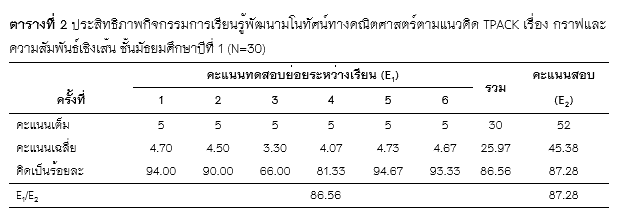การพัฒนากิจกรรมการเรียนรู้ตามแนวคิด TPACK เรื่อง กราฟและความสัมพันธ์เชิงเส้น เพื่อส่งเสริมความเข้าใจเชิงมโนทัศน์ทางคณิตศาสตร์ของนักเรียนชั้นมัธยมศึกษาปีที่ 1
Main Article Content
บทคัดย่อ
การวิจัยนี้มีจุดประสงค์เพื่อ 1) พัฒนาและหาประสิทธิภาพของกิจกรรมการเรียนรู้ที่พัฒนาตามแนวคิด TPACK เรื่อง กราฟและความสัมพันธ์เชิงเส้น ให้มีประสิทธิภาพตามเกณฑ์ 75/75 2) ศึกษาระดับความเข้าใจเชิงมโนทัศน์ทางคณิตศาสตร์ เรื่อง กราฟและความสัมพันธ์เชิงเส้นของนักเรียนชั้นมัธยมศึกษาปีที่ 1 3) ศึกษาความพึงพอใจของนักเรียนที่มีต่อกิจกรรมการเรียนรู้ตามแนวคิด TPACK เรื่อง กราฟและความสัมพันธ์เชิงเส้น กลุ่มเป้าหมาย คือ นักเรียนชั้นมัธยมศึกษาปีที่ 1 จำนวน 30 คน ได้มาโดยการเลือกแบบเจาะจง เครื่องมือที่ใช้ในการวิจัย ได้แก่ แผนการจัดการเรียนรู้และกิจกรรมการเรียนรู้ตามแนวคิด TPACK เรื่อง กราฟและความสัมพันธ์เชิงเส้น แบบทดสอบวัดความเข้าใจเชิงมโนทัศน์ทางคณิตศาสตร์ แบบประเมินความพึงพอใจ วิเคราะห์ข้อมูลโดยหาค่าร้อยละ ค่าเฉลี่ย และค่าส่วนเบี่ยงเบนมาตรฐาน
ผลการวิจัยพบว่า 1) กิจกรรมการเรียนรู้ที่พัฒนาตามแนวคิด TPACK ที่ส่งเสริมมโนทัศน์ทางคณิตศาสตร์เรื่อง กราฟและความสัมพันธ์เชิงเส้น มีค่าประสิทธิภาพ (E1/E2) เท่ากับ 86.56/87.28 ซึ่งสูงกว่าเกณฑ์ที่กำหนดไว้
2) หลังเรียนด้วยกิจกรรมการเรียนรู้ที่พัฒนาตามแนวคิด TPACK เรื่อง กราฟและความสัมพันธ์เชิงเส้น คะแนนความเข้าใจเชิงมโนทัศน์ทางคณิตศาสตร์ของนักเรียนอยู่ในระดับการกระทำ (A) สูงสุด รองลงมาคือ กระบวนการ (P) และสิ่งที่เรียนรู้ (O) ตามลำดับ และ 3) นักเรียนมีความพึงพอใจต่อกิจกรรมการเรียนรู้ตามแนวคิด TPACK ในภาพรวมอยู่ในระดับมาก (µ = 4.47, σ = 0.78)
Downloads
Article Details

อนุญาตภายใต้เงื่อนไข Creative Commons Attribution-NonCommercial-NoDerivatives 4.0 International License.
เอกสารอ้างอิง
Arnawa, I. M., Kartasasmita, B., & Baskoro, E. T. (2007). Applying the APOS theory to improve students’ ability to prove in elementary abstract algebra. Journal of the Indonesian Mathematical Society, 133-148.
Arnon, I., Cottrill, J., Dubinsky, E., Oktac, A., Roa, S., Trigueros, M., and Weller, K. (2014). APOS theory: A framework for research and curriculum development in mathematics education. Springer, NY: Heidelberg, Dordrecht, London.
Adulyasas, L. (2018). The Effects of Developing Pre-Service Mathematics Teachers’ Technological Pedagogical Content Knowledge (TPACK) on Mathematics Students’ Achievement. Journal of Yala Rajabhat University, 13(1), 115-128. [in Thai]
Baye, M. G., Ayele, M. A., & Wondimuneh, T. E. (2021). Implementing GeoGebra integrated with multi-teaching approaches guided by the APOS theory to enhance students’ conceptual understanding of limit in Ethiopian Universities. Heliyon, 7(5), e07012.
Janhom, P. (2018). The development of mathematical concept with learning activities based on concrete-pictorial-abstract (C-P-A) approach on two-dimensional and three-dimensional geometry for 7th grade tudents. (Master Of Education (Mathematics Education), Graduate school Naresuan University). [in Thai]
Kilpatrick, J., Swafford, J., and Findell, B. (2001). Adding it up: Helping children learn mathematics. Washington, DC: National Academies Press.
Makanong, A. (2003). Mathematics: Teaching and Learning. Bangkok: Center for Textbooks and Academic Papers Chulalongkorn University. [in Thai]
Makanong, A. (2014). Mathematics for high school teacher. Bangkok: Chulalongkorn University. [in Thai]
Mishra, P., and Koehler, M.J. (2006). Technological pedagogical content knowledge: A new framework for teacher knowledge. Teachers College Record, 108(6), 1017-1054.
National Council of Teachers of Mathematics. (2000). Principle and standards for school mathematics. Reston, VA: National Council of Teachers of Mathematics.
National PISA Operations Center, Institute for the Promotion of Teaching Science and Technology (IPST). (2021). PISA 2015 results: Reading, mathematics, and science. Bangkok: The Institute for the Promotion of Teaching Science and Technology (IPST). [in Thai]
National Institute of Education Testing service (Public Organization) (NIETS). (2020). The report of results: Ordinary National Educational Test (O-NET) 2020. Retrieved from https://www.niets.or.th/th/catalog/view/2989
National Institute of Education Testing service (Public Organization) (NIETS). (2021). The report of results: Ordinary National Educational Test (O-NET) 2021. Retrieved from https://www.niets.or.th/th/catalog/view/2989
The Institute for the Promotion of Teaching Science and Technology (IPST). (2018). PISA 2015 results: Science, reading and mathematics excellence and equality in education. Bangkok: The Institute for the Promotion of Teaching Science and Technology (IPST). [in Thai]
Prachumkayohmat, S. (2019). Study of the mathematical conceptual understanding of prathomsuksa six students on measurements of length and weight. (The Degree of Doctor of Education (Mathematics), Faculty of Science, Srinakharinwirot University). [in Thai]
Promtrud, A. (2022). Development of conceptual understanding in mathematics of 7th grade students using open approach: Classroom action research. Chiang Mai University Journal of Education, 6(2), 61 – 75. [in Thai]
Saengrung, P, Khoonchoom, T, Seesomba, S, and Pumsanthia, U. (2022). the development of game application for learning of the adding and subtracting for 2nd grade students. Chiang Mai University Journal of Education, 6(1), 44 – 57. [in Thai]
The Institute for the Promotion of Teaching Science and Technology (IPST). (2015). Mathematics education at the Thai school level: development – impact – current recession. Retrieved from https://pisathailand.ipst.ac.th/ipst-958/ [in Thai]
The Institute for the Promotion of Teaching Science and Technology (IPST), Ministry of Education. (2017). Curriculum Manual for Mathematics Learning (Revised Edition 2017). Bangkok: The Institute for the Promotion of Teaching Science and Technology (IPST). [in Thai]
Thinwiangthong, S., Ya-amphan, D., and Woranetsudathip, N. (2022). New normal mathematics teaching practice integrating technological pedagogical content knowledge in cycle of professional learning community. Journal of Education Khon Kaen University, 45(1), 115-129. [in Thai]
Khonyutrakul, C., Sriarunrasmee, J., and Sriprasertpap, K. (2019). Development of learning activity package combined with augmented reality in mathematics to promote analytical thinking ability among grade six students. Jurnal of Graduate Research, 10(2), 39-54. [in Thai]


